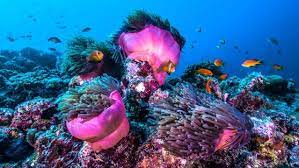The UN High Seas treaty says 30 percent of international waters will be designated as sanctuaries by 2030. The idea: protect threatened species and reverse biodiversity losses.
The United Nations has voted to designate 30 percent of the world’s oceans as protected areas by 2030. The High Seas Treaty was agreed to by member nations on Saturday evening at New York’s UN headquarters after ten days of talks. The treaty—which got its start ten years ago—threatened to unravel at the last minute because of fishing rights and funding issues.
The goal is to create marine sanctuaries in the high seas—international waters where all countries have a right to fish and do research—to allow species to recuperate. Only 1.2 percent of those waters are now protected. The International Union for Conservation of Nature (IUCN) has said that 10 percent of marine species are at risk of extinction, mostly because of overfishing and climate change. Other groups are concerned about the potential for undersea mining and the unknown impact it might have on breeding grounds and habitats.

“This is a historic day for conservation and a sign that in a divided world, protecting nature and people can triumph over geopolitics,” said Laura Meller, an oceans campaigner for Greenpeace Nordic. She commended countries for “putting aside differences and delivering a treaty that will let us protect the oceans, build our resilience to climate change and safeguard the lives and livelihoods of billions of people.”
Dr. Robert Blasiak, ocean researcher at Stockholm University, said the treaty points to an ocean that is still, in many ways, a mystery. “If you imagine a big, high-definition, widescreen TV, and if only like three or four of the pixels on that giant screen are working, that’s our knowledge of the deep ocean,” he told the BBC. “We’ve recorded about 230,000 species in the ocean, but it’s estimated that there are over two million.”

The International Seabed Authority said that “any future activity in the deep seabed will be subject to strict environmental regulations and oversight to ensure that they are carried out sustainably and responsibly.”
The goal of the treaty is to reverse biodiversity losses. “The two biggest causes [of extinction] are overfishing and pollution,” said Dr Ngozi Oguguah, chief research officer at Nigerian Institute for Oceanography and Marine Research. “If we have marine protected sanctuaries most of the marine resources will have the time to recover.”
Countries still need to formally approve the agreement. Then work needs to start on the logistics of how the protected areas will operate. “It will take some time to take effect,” Liz Karan, director of Pews Trust ocean governance team, told the BBC. “Countries have to ratify it. Then there are a lot of institutional bodies like the Science and Technical Committee that have to get set up.”






